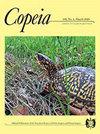Trends in Chondrichthyan Research: An Analysis of Three Decades of Conference Abstracts
IF 2.6
Q2 Agricultural and Biological Sciences
引用次数: 14
Abstract
Given the conservation status and ecological, cultural, and commercial importance of chondrichthyan fishes, it is valuable to evaluate the extent to which research attention is spread across taxa and geographic locations and to assess the degree to which scientific research is appropriately addressing the challenges they face. Here we review trends in research effort over three decades (1985–2016) through content analysis of every abstract (n = 2,701) presented at the annual conference of the American Elasmobranch Society (AES), the oldest and largest professional society focused on the scientific study and management of these fishes. The most common research areas of AES abstracts were reproductive biology, movement/telemetry, age and growth, population genetics, and diet/feeding ecology, with different areas of focus for different study species or families. The most commonly studied species were large and charismatic (e.g., White Shark, Carcharodon carcharias), easily accessible to long-term established field research programs (e.g., Lemon Shark, Negaprion brevirostris, and Sandbar Shark, Carcharhinus plumbeus), or easily kept in aquaria for lab-based research (e.g., Bonnethead Shark, Sphyrna tiburo). Nearly 90% of all described chondrichthyan species have never been mentioned in an AES abstract, including some of the most threatened species in the Americas. The proportion of female* first authors has increased over time, though many current female* Society members are graduate students. Nearly half of all research presented at AES occurred in the waters of the United States rather than in the waters of developing nations where there are more threatened species and few resources for research or management. Presentations based on research areas such as paleontology and aquarium-based research have declined in frequency over time, and identified research priorities such as social science and interdisciplinary research are poorly represented. Possible research gaps and future research priorities for the study of chondrichthyan fishes are also discussed.软骨细胞研究的趋势——对三十年会议摘要的分析
鉴于软骨鱼的保护现状及其在生态、文化和商业方面的重要性,评估研究注意力在不同分类群和地理位置上的分布程度,以及评估科学研究在多大程度上适当地解决了它们面临的挑战,是有价值的。在这里,我们回顾了过去三十年(1985年至2016年)的研究趋势,通过对美国Elasmobranch学会(AES)年度会议上发表的每篇摘要(n = 2701)的内容分析。AES是专注于这些鱼类的科学研究和管理的历史最悠久、规模最大的专业学会。AES摘要最常见的研究领域是生殖生物学、运动/遥测、年龄与生长、种群遗传学和饮食/饲养生态学,不同研究物种或科的研究领域不同。最常见的研究物种是大型和有魅力的(例如,白鲨,Carcharodon carcharias),易于长期建立的实地研究计划(例如,柠檬鲨,Negaprion brevirostris,沙洲鲨,Carcharhinus plumbeus),或者易于在水族馆中进行实验室研究(例如,bonnehead Shark, Sphyrna tiburo)。近90%被描述的软骨鱼物种从未在AES摘要中被提及,包括美洲一些最受威胁的物种。随着时间的推移,女性第一作者的比例有所增加,尽管目前许多女性学会成员都是研究生。在AES上进行的所有研究中,近一半是在美国水域进行的,而不是在发展中国家的水域进行的。发展中国家的水域有更多的受威胁物种,可供研究或管理的资源很少。基于古生物学和水族馆研究等研究领域的演讲频率随着时间的推移而下降,而确定的研究重点,如社会科学和跨学科研究的代表性不足。讨论了软骨鱼研究可能存在的研究空白和未来的研究重点。
本文章由计算机程序翻译,如有差异,请以英文原文为准。
求助全文
约1分钟内获得全文
求助全文
来源期刊

Copeia
生物-动物学
CiteScore
2.10
自引率
0.00%
发文量
0
审稿时长
6-12 weeks
期刊介绍:
Founded in 1913, Copeia is a highly respected international journal dedicated to the publication of high quality, original research papers on the behavior, conservation, ecology, genetics, morphology, evolution, physiology, systematics and taxonomy of extant and extinct fishes, amphibians, and reptiles. Copeia is published electronically and is available through BioOne. Articles are published online first, and print issues appear four times per year. In addition to research articles, Copeia publishes invited review papers, book reviews, and compiles virtual issues on topics of interest drawn from papers previously published in the journal.
 求助内容:
求助内容: 应助结果提醒方式:
应助结果提醒方式:


